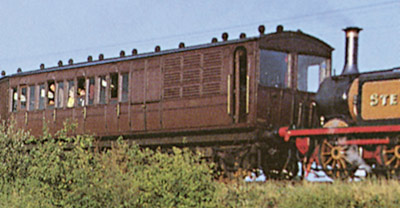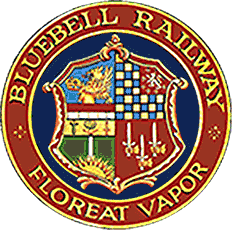
 Originally built as a steam-hauled brake coach, with five passenger compartments, it was converted for electric operation as a Driving Motor Luggage Third in 1907/8,with only three passenger compartments, the fourth compartment being used by the guard, and what is now the guard's van containing the electrical gear, with metal louvres for ventilation.
Originally built as a steam-hauled brake coach, with five passenger compartments, it was converted for electric operation as a Driving Motor Luggage Third in 1907/8,with only three passenger compartments, the fourth compartment being used by the guard, and what is now the guard's van containing the electrical gear, with metal louvres for ventilation.
It was reconverted for steam haulage on the Metropolitan's Chesham Branch in 1940 as LT No.512, with the electrical equipment stripped out, creating a large luggage van space. The fourth compartment was no longer required for the guard, and was returned to passenger use. The interior fittings, panelling and seats for this compartment (and the vacuum brake gear for all the carriages) were taken from some of the Met 'Dreadnaught' stock which was being withdrawn from service at that time.
Above right: A 1961 photo taken soon after the arrival of the carriages on the Bluebell (David Clark).
The photo above shows 387 at the south end of the train which was stopped at 'Bluebell Halt', our temporary terminus just south of New Road Bridge, used until we gained access to platform 3/4 (as it then was) at Horsted Keynes station. Because there was no loop at that point, trains were all topped-and-tailed by a pair of locomotives.

 Left: For the 1962 season the carriages were repainted into an early Metropolitan livery (the brown areas would originally have been varnished teak). Then in 1963 the set returned for a visit to the Metropolitan Line for its centenary celebrations, just as they did 50 years later for Met-150!
Left: For the 1962 season the carriages were repainted into an early Metropolitan livery (the brown areas would originally have been varnished teak). Then in 1963 the set returned for a visit to the Metropolitan Line for its centenary celebrations, just as they did 50 years later for Met-150!
387 was extensively used on the Bluebell during the sixties, since when it was been out of service pending overhaul, except for use by the Railway's Fire department as their one-time headquarters, and for filming work including being painted white to appear as a ghost train in "I'll never forget what's 'is name" in 1967.

 When its overhaul started, as part of the BASH (Bluebell Ashbury Supporters and Helpers) project to return the set of four "Chesham" vehicles to working order, the first job in February 1992 was to lift it from its bogies. The bogies were comprehensively overhauled, as were the buffers, vacuum brake system and the electrical system (dynamo, battery boxes and wiring), whilst the coach sat outside on trestles under a tarpaulin. Simultaneously the bodywork on the coach from the other end of the set, No. 394, was tackled. The two coaches had to return to service simultaneously because the set is "close coupled", only having conventionional couplings and buffers at the outer ends.
When its overhaul started, as part of the BASH (Bluebell Ashbury Supporters and Helpers) project to return the set of four "Chesham" vehicles to working order, the first job in February 1992 was to lift it from its bogies. The bogies were comprehensively overhauled, as were the buffers, vacuum brake system and the electrical system (dynamo, battery boxes and wiring), whilst the coach sat outside on trestles under a tarpaulin. Simultaneously the bodywork on the coach from the other end of the set, No. 394, was tackled. The two coaches had to return to service simultaneously because the set is "close coupled", only having conventionional couplings and buffers at the outer ends.
Right: The coach, as restored, on its test run, January 1999 (Lewis Nodes).
Work on the body has included the reconstruction of the brake end in its original form with narrow windows for the guard. Samples of paint covered over in 1908 reveal the original colour scheme of the interior of the brake van, which has been reproduced.

 In the Spring of 1999 the Transport Trust awarded us The Peter Allen Award and a cheque for £750, which has been used
for further restoration work on the Metropolitan Coaches. The competition
was for projects not completed at the time of judgeing, but due for
completion within a year. This carriage returned to public service on 13th February 1999 after more than 30 years out of use and a 7-year-long overhaul.
In the Spring of 1999 the Transport Trust awarded us The Peter Allen Award and a cheque for £750, which has been used
for further restoration work on the Metropolitan Coaches. The competition
was for projects not completed at the time of judgeing, but due for
completion within a year. This carriage returned to public service on 13th February 1999 after more than 30 years out of use and a 7-year-long overhaul.
Left: The formal relaunch of the full set of four carriages took place in July 2007, with the appropriate locomotive Met.1 hired in for the event. The curved handrails had by this time also been fitted, following further research into the original appearance of the carriage end.

 Type: Metropolitan Railway "Bogie Stock" Brake 3rd
Type: Metropolitan Railway "Bogie Stock" Brake 3rd
Built: (Ashbury) 1898
Rebuilt: 1907/8
Seating: 50 3rd as built, 30 3rd (1908-1940) and 40 3rd from 1940
Length: 39' 6"
Weight: 20 Tons
Original No: 387
Other Nos: 2761, 512
Withdrawn: 1960
Preserved: 1961
To Bluebell: 2/3/1961
Right: The interior of one of the compartments, re-trimmed in reproduced Met-line "Tribolite" moquette, a 1954 design by Jack Thompson (James Young).
Details of No. 387's restoration are on a separate page.
A series of web pages are dedicated to details of the history and restoration of the four Metropolitan coaches.














